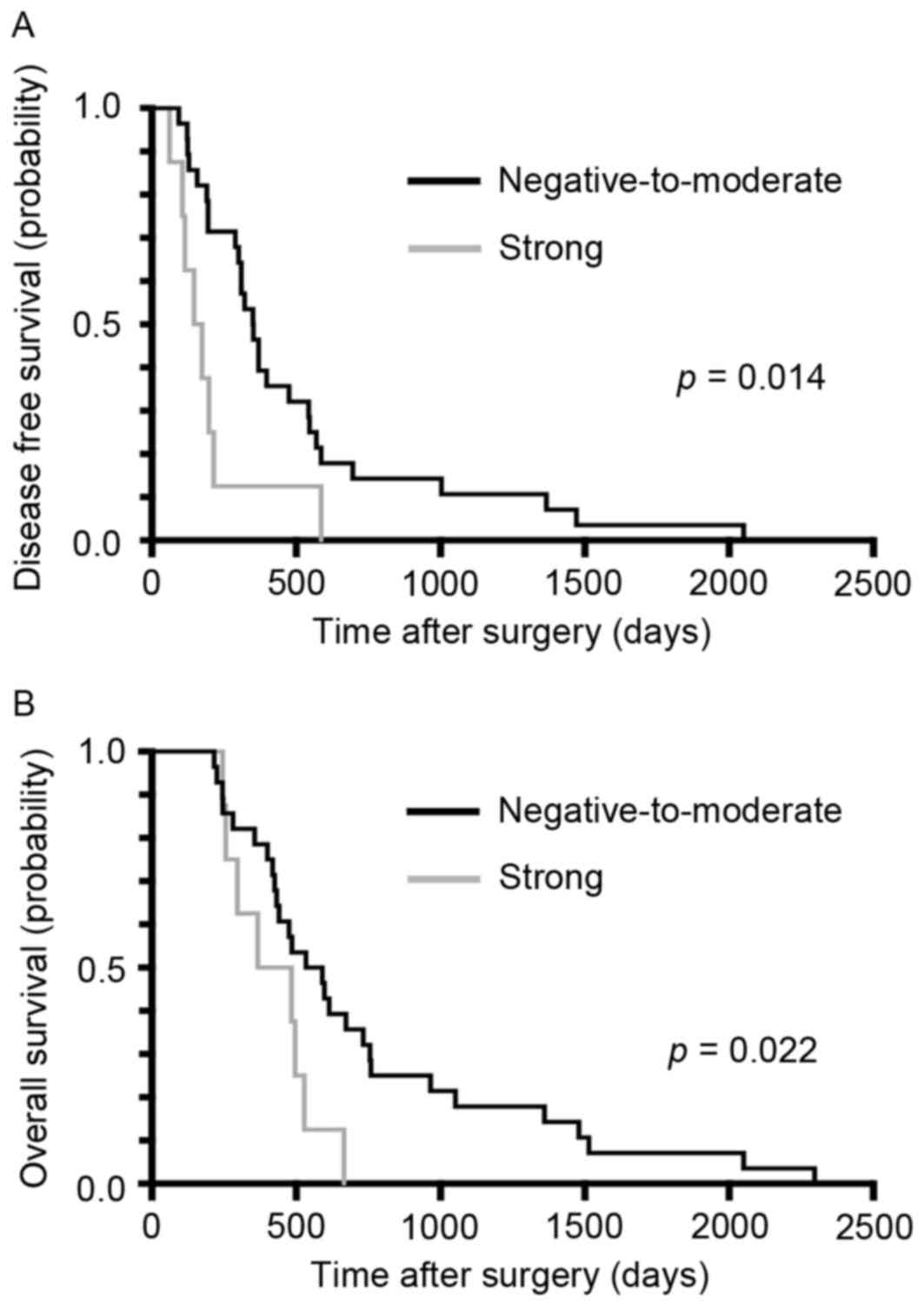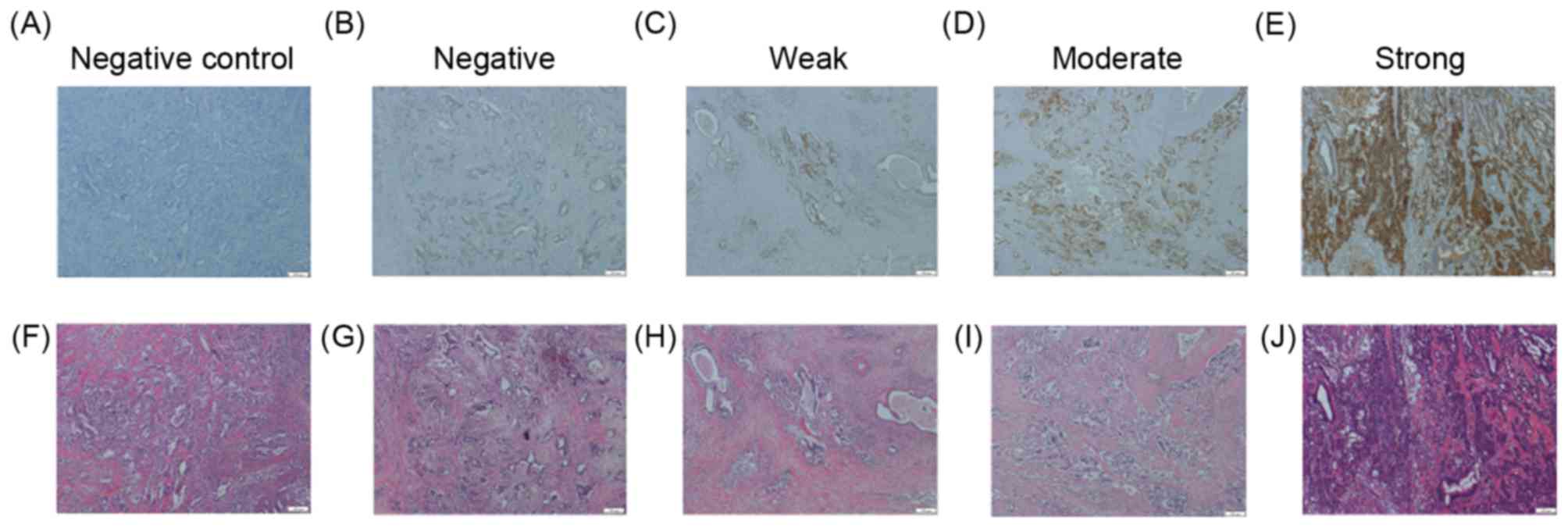|
1
|
Jemal A, Siegel R, Xu J and Ward E: Cancer
statistics, 2010. CA Cancer J Clin. 60:277–300. 2010. View Article : Google Scholar : PubMed/NCBI
|
|
2
|
Stathis A and Moore MJ: Advanced
pancreatic carcinoma: Current treatment and future challenges. Nat
Rev Clin Oncol. 7:163–172. 2010. View Article : Google Scholar : PubMed/NCBI
|
|
3
|
Chari ST, Kelly K, Hollingsworth MA,
Thayer SP, Ahlquist DA, Andersen DK, Batra SK, Brentnall TA, Canto
M, Cleeter DF, et al: Early detection of sporadic pancreatic
cancer: Summative review. Pancreas. 44:693–712. 2015. View Article : Google Scholar : PubMed/NCBI
|
|
4
|
Arslan C and Yalcin S: Current and future
systemic treatment options in metastatic pancreatic cancer. J
Gastrointest Oncol. 5:280–295. 2014.PubMed/NCBI
|
|
5
|
Fischer R, Breidert M, Keck T, Makowiec F,
Lohrmann C and Harder J: Early recurrence of pancreatic cancer
after resection and during adjuvant chemotherapy. Saudi J
Gastroenterol. 18:118–121. 2012. View Article : Google Scholar : PubMed/NCBI
|
|
6
|
Pothacharoen P, Siriaunkgul S, Ong-Chai S,
Supabandhu J, Kumja P, Wanaphirak C, Sugahara K, Hardingham T and
Kongtawelert P: Raised serum chondroitin sulfate epitope level in
ovarian epithelial cancer. J Biochem. 140:517–524. 2006. View Article : Google Scholar : PubMed/NCBI
|
|
7
|
Vallen MJ, Schmidt S, Oosterhof A, Bulten
J, Massuger LF and van Kuppevelt TH: Primary ovarian carcinomas and
abdominal metastasis contain 4,6-disulfated chondroitin sulfate
rich regions, which provide adhesive properties to tumour cells.
PLoS One. 9:e1118062014. View Article : Google Scholar : PubMed/NCBI
|
|
8
|
Ricciardelli C, Mayne K, Sykes PJ, Raymond
WA, McCaul K, Marshall VR, Tilley WD, Skinner JM and Horsfall DJ:
Elevated stromal chondroitin sulfate glycosaminoglycan predicts
progression in early-stage prostate cancer. Clin Cancer Res.
3:983–992. 1997.PubMed/NCBI
|
|
9
|
Ricciardelli C, Quinn DI, Raymond WA,
McCaul K, Sutherland PD, Stricker PD, Grygiel JJ, Sutherland RL,
Marshall VR, Tilley WD and Horsfall DJ: Elevated levels of
peritumoral chondroitin sulfate are predictive of poor prognosis in
patients treated by radical prostatectomy for early-stage prostate
cancer. Cancer Res. 59:2324–2328. 1999.PubMed/NCBI
|
|
10
|
Vallen MJ, van der Steen SC, van Tilborg
AA, Massuger LF and van Kuppevelt TH: Sulfated sugars in the
extracellular matrix orchestrate ovarian cancer development: ‘when
sweet turns sour’. Gynecol Oncol. 135:371–381. 2014. View Article : Google Scholar : PubMed/NCBI
|
|
11
|
van der Steen SC, van Tilborg AA, Vallen
MJ, Bulten J, van Kuppevelt TH and Massuger LF: Prognostic
significance of highly sulfated chondroitin sulfates in ovarian
cancer defined by the single chain antibody GD3A11. Gynecol Oncol.
140:527–536. 2016. View Article : Google Scholar : PubMed/NCBI
|
|
12
|
ten Dam GB, van de Westerlo EM,
Purushothaman A, Stan RV, Bulten J, Sweep FC, Massuger LF, Sugahara
K and van Kuppevelt TH: Antibody GD3G7 selected against embryonic
glycosaminoglycans defines chondroitin sulfate-E domains highly
up-regulated in ovarian cancer and involved in vascular endothelial
growth factor binding. Am J Pathol. 171:1324–1333. 2007. View Article : Google Scholar : PubMed/NCBI
|
|
13
|
Wegrowski Y and Maquart F: Chondroitin
sulfate proteoglycans in tumor progression. Adv Pharmacol.
53:297–321. 2006. View Article : Google Scholar : PubMed/NCBI
|
|
14
|
Mizumoto S, Watanabe M, Yamada S and
Sugahara K: Expression of N-acetylgalactosamine 4-sulfate
6-O-sulfotransferase involved in chondroitin sulfate synthesis is
responsible for pulmonary metastasis. Biomed Res Int.
2013:6563192013. View Article : Google Scholar : PubMed/NCBI
|
|
15
|
Ohtake S, Ito Y, Fukuta M and Habuchi O:
Human N-acetylgalactosamine 4-sulfate 6-O-sulfotransferase cDNA is
related to human B cell recombination activating gene-associated
gene. J Biol Chem. 276:43894–43900. 2001. View Article : Google Scholar : PubMed/NCBI
|
|
16
|
Takakura K, Shibazaki Y, Yoneyama H, Fujii
M, Hashiguchi T, Ito Z, Kajihara M, Misawa T, Homma S, Ohkusa T and
Koido S: Inhibition of cell proliferation and growth of pancreatic
cancer by silencing of carbohydrate sulfotransferase 15 in vitro
and in a Xenograft model. PLoS One. 10:e01429812015. View Article : Google Scholar : PubMed/NCBI
|
|
17
|
Sugahara KN, Hirata T, Tanaka T, Ogino S,
Takeda M, Terasawa H, Shimada I, Tamura J, ten Dam GB, van
Kuppevelt TH and Miyasaka M: Chondroitin sulfate E fragments
enhance CD44 cleavage and CD44-dependent motility in tumor cells.
Cancer Res. 68:7191–7199. 2008. View Article : Google Scholar : PubMed/NCBI
|
|
18
|
Thomas L, Byers HR, Vink J and Stamenkovic
I: CD44H regulates tumor cell migration on hyaluronate-coated
substrate. J Cell Biol. 118:971–977. 1992. View Article : Google Scholar : PubMed/NCBI
|
|
19
|
Günthert AR, Sträter J, von Reyher U,
Henne C, Joos S, Koretz K, Moldenhauer G, Krammer PH and Möller P:
Early detachment of colon carcinoma cells during CD95
(APO-1/Fas)-mediated apoptosis. I. De-adhesion from hyaluronate by
shedding of CD44. J Cell Biol. 134:1089–1096. 1996. View Article : Google Scholar : PubMed/NCBI
|
|
20
|
Goebeler M, Kaufmann D, Bröcker EB and
Klein CE: Migration of highly aggressive melanoma cells on
hyaluronic acid is associated with functional changes, increased
turnover and shedding of CD44 receptors. J Cell Sci. 109:1957–1964.
1996.PubMed/NCBI
|
|
21
|
Hirata K, Suzuki H, Imaeda H, Matsuzaki J,
Tsugawa H, Nagano O, Asakura K, Saya H and Hibi T: CD44 variant 9
expression in primary early gastric cancer as a predictive marker
for recurrence. Br J Cancer. 109:379–386. 2013. View Article : Google Scholar : PubMed/NCBI
|
|
22
|
Cho Y, Lee HW, Kang HG, Kim HY, Kim SJ and
Chun KH: Cleaved CD44 intracellular domain supports activation of
stemness factors and promotes tumorigenesis of breast cancer.
Oncotarget. 6:8709–8721. 2015. View Article : Google Scholar : PubMed/NCBI
|
|
23
|
Yang JJ, Hu ZG, Shi WX, Deng T, He SQ and
Yuan SG: Prognostic significance of neutrophil to lymphocyte ratio
in pancreatic cancer: A meta-analysis. World J Gastroenterol.
21:2807–2815. 2015. View Article : Google Scholar : PubMed/NCBI
|
|
24
|
Takakura K, Ito Z, Suka M, Kanai T,
Matsumoto Y, Odahara S, Matsudaira H, Haruki K, Fujiwara Y, Saito
R, et al: Comprehensive assessment of the prognosis of pancreatic
cancer: Peripheral blood neutrophil-lymphocyte ratio and
immunohistochemical analyses of the tumour site. Scand J
Gastroenterol. 51:610–617. 2016. View Article : Google Scholar : PubMed/NCBI
|
|
25
|
Edge SB and Compton CC: The American Joint
Committee on Cancer: The 7th edition of the AJCC cancer staging
manual and the future of TNM. Ann Surgi Oncol. 17:1471–1474. 2010.
View Article : Google Scholar
|
|
26
|
Metindir J, Dilek GB and Pak I: Staining
characterization by immunohistochemistry of tumor cancer antigen in
patients with endometrial cancer. Eur J Gynaecol Oncol. 29:489–492.
2008.PubMed/NCBI
|
|
27
|
Lara MF, González-González E, Speaker TJ,
Hickerson RP, Leake D, Milstone LM, Contag CH and Kaspar RL:
Inhibition of CD44 gene expression in human skin models, using
self-delivery short interfering RNA administered by dissolvable
microneedle arrays. Hum Gene Ther. 23:816–823. 2012. View Article : Google Scholar : PubMed/NCBI
|
|
28
|
Kugelman LC, Ganguly S, Haggerty JG,
Weissman SM and Milstone LM: The core protein of epican, a heparan
sulfate proteoglycan on keratinocytes, is an alternative form of
CD44. J Invest Dermatol. 99:886–891. 1992. View Article : Google Scholar : PubMed/NCBI
|
|
29
|
Nishimura M, Yahagi N, Itoi T, Ochiai Y
and Matsuda Y: A translational study to investigate the role of
carbohydrate sulfotransferase 15 for pancreatic cancer biology from
in vitro to first-in-human clinical research. J Clin Oncol.
33:e222012015.
|













